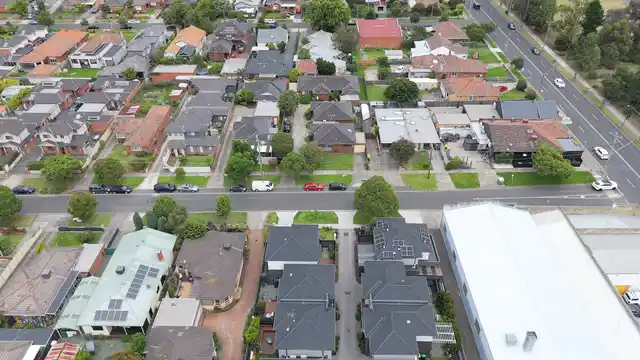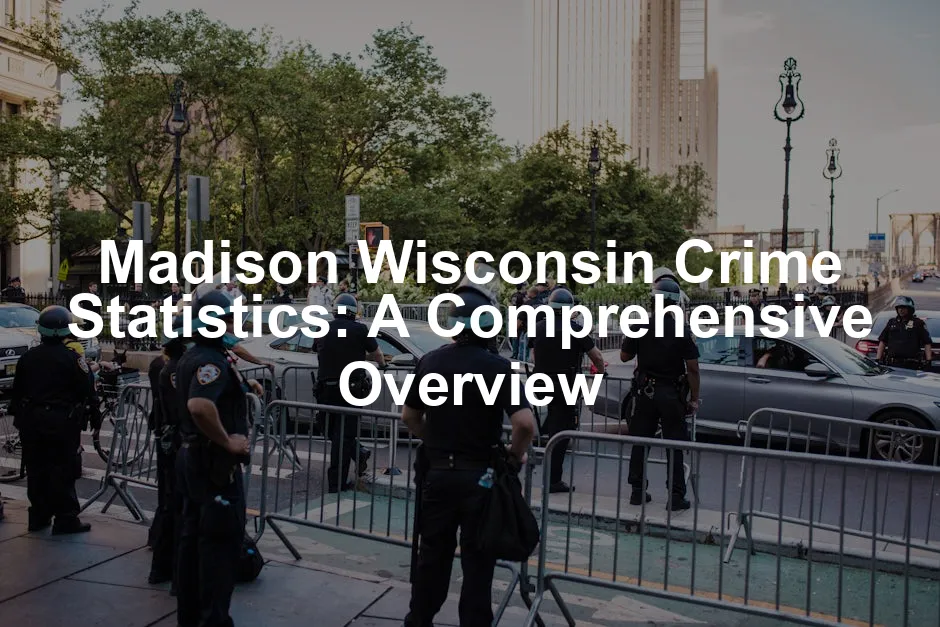Introduction
Madison, Wisconsin, is not just the state capital; it’s a vibrant city bursting with culture and educational opportunities. Home to the renowned University of Wisconsin-Madison, the city offers a unique blend of academic prowess and community spirit. From its lively downtown to serene parks, Madison draws residents and visitors alike. However, understanding crime statistics is crucial for everyone—residents, potential movers, and policymakers. Analyzing these figures helps individuals make informed decisions about safety and community engagement.
Understanding crime statistics in Madison is essential for informed decision-making. madison crime statistics
In this article, we aim to present an in-depth analysis of Madison’s crime statistics. We will compare these figures with state and national averages, offering a comprehensive overview of safety trends. Additionally, we’ll highlight critical insights that can guide residents towards safer living environments. So, buckle up—it’s time to crunch some numbers and explore what Madison’s crime landscape looks like!

Crime Overview in Madison
General Crime Statistics
Madison’s crime rate is notably higher than the national average, with approximately 28 crimes reported per 1,000 residents. This statistic might raise eyebrows, but don’t panic just yet! While Madison isn’t among the safest cities in America, it still has much to offer. The overall chance of becoming a victim of crime in Madison stands at 1 in 36. Delving deeper, the odds for violent crime are 1 in 332, while property crime has a likelihood of 1 in 41.
When examining total crime rates per 100,000 people, Madison shows an alarming figure compared to the national average. Madison’s violent crime rate hovers around 305 incidents per 100,000, whereas the national median is higher at 388. For property crime, Madison has a rate of 2,779, significantly exceeding the national average of 1,958. These figures paint a sobering picture but are essential for understanding the city’s safety dynamics.

To enhance your home safety, consider investing in a Home Security Camera System. With real-time monitoring and alerts, it gives you peace of mind knowing you can keep an eye on your property anytime, anywhere. After all, it’s better to be safe than sorry!
Violent vs. Property Crime
It’s crucial to differentiate between violent and property crimes when discussing safety. Violent crimes include offenses that harm individuals, such as murder, rape, robbery, and aggravated assault. In Madison, the violent crime rate has been recorded at 3 incidents per 1,000 residents, totaling 822 violent crimes reported. Breaking it down, there were 6 murders, 90 rapes, 114 robberies, and a staggering 612 assaults last year.
On the other hand, property crimes refer to offenses involving theft or damage to possessions. Madison experiences a property crime rate of 25 per 1,000 residents, with a total of 6,727 incidents. These comprise 944 burglaries, a whopping 5,101 thefts, and 682 motor vehicle thefts. When juxtaposed with national figures, Madison’s property crime rate is considerably high, highlighting areas needing improvement and community support.
If you’re concerned about your personal safety, a Self-Defense Keychain can be a handy tool. Lightweight and discreet, it ensures you’re prepared for any unexpected situations. Because let’s face it, we all want to feel like superheroes sometimes!
In conclusion, while crime rates in Madison might seem daunting, it’s essential to remain informed. Understanding these statistics can empower residents to take proactive measures, fostering a safer community for all.

Detailed Analysis of Violent Crime
Types of Violent Crimes
When we talk about violent crime, we’re tackling the heavy hitters: murder, rape, robbery, and aggravated assault. In Madison, the statistics for these crimes paint a vivid picture.
Starting with murder, Madison reported 6 incidents last year. This number is lower than both the state average of 7.3 and the national average of 6.9 per 100,000 people. Not too shabby, right?
Now, let’s move on to rape. The city recorded 90 rapes, a figure that hovers near the state average of 84 and is somewhat lower than the national average of 100. This crime remains a serious concern, and the community is actively working to address it.
Robbery is another story. Madison had 114 reported robberies. This number is higher than the state average of 40 and the national average of 129. The uptick in robberies has caused some alarm among locals.
Aggravated assault? Madison reported a staggering 612 incidents last year. Comparatively, this is higher than the state average of 298 and the national average of 250. It seems that this category is where Madison really stands out, and not in a good way.
Looking at trends, violent crime in Madison has seen some fluctuations. From 2020 to 2021, there was a 22% decrease in violent crimes, which sounds promising. However, in 2022, the city experienced a slight uptick, particularly in robbery and aggravated assault. This ebb and flow of statistics can often leave residents scratching their heads—are we moving forward or backward?

Neighborhood Impact
Some neighborhoods in Madison have higher rates of violent crime than others. Areas like Wexford Ridge and North Lake Mendota have become infamous for their crime statistics. Wexford Ridge, for instance, reports a violent crime rate of 1,589 per 100,000 people. That’s enough to make anyone think twice about a midnight stroll.
But why do these neighborhoods experience higher crime rates? Socioeconomic factors play a significant role. These areas often struggle with poverty, unemployment, and a lack of resources. When communities face these challenges, crime can become an unfortunate byproduct.
Local law enforcement and community organizations are stepping up their efforts to improve safety. The Madison Police Department has increased patrols in high-crime areas and launched community engagement initiatives. These programs aim to build trust between law enforcement and residents while promoting safety awareness.
Community organizations are also working tirelessly to provide resources and support to those in need. Initiatives focused on youth engagement, job training, and mental health services can make a difference. People are coming together, determined to tackle the root causes of crime and make Madison a safer place for all.
In conclusion, understanding the types and trends of violent crime in Madison helps residents stay informed. It empowers them to engage with community efforts and advocate for safer neighborhoods. While challenges remain, the commitment to progress is evident. Together, residents and law enforcement can work toward a brighter, safer future.

Detailed Analysis of Property Crime
Types of Property Crimes
Property crime in Madison includes burglary, theft, and motor vehicle theft. Unfortunately, these crimes paint a more daunting picture compared to their violent counterparts.
Madison reported 944 burglaries last year. This figure is significantly higher than the state average of 500 and the national average of 400. A large number of residents worry about the safety of their homes.
Theft is even more concerning. With 5,101 incidents, Madison’s theft rate dwarfs the state average of 1,500 and the national average of 1,400. This statistic highlights the pervasive nature of theft in the city. It’s as if thieves have taken a keen interest in the local treasures.
Motor vehicle theft follows suit with 682 reported cases. Again, this rate is higher than the state average of 240 and the national average of 280. If you own a car in Madison, it’s wise to invest in a good alarm system and always lock your doors. Consider a Car Alarm System to help deter thieves and protect your vehicle.
It’s essential to consider how these property crimes impact residents’ perceptions of safety. After all, feeling secure in one’s home is a top priority, and rising crime rates can lead to anxiety and fear. Many residents express concerns about leaving their homes unattended or parking in certain areas, which can diminish their overall quality of life.

Neighborhood Impact
Just as with violent crime, certain neighborhoods experience higher rates of property crime. Areas like Emerson East and Brentwood Village stand out for their troubling statistics. Residents in these neighborhoods often share stories of break-ins and theft, which can lead to feelings of helplessness.
Factors contributing to these property crime spikes include economic conditions and housing market trends. High housing costs can exacerbate financial struggles, prompting some individuals to resort to theft. Meanwhile, increasing property values in some neighborhoods can create a target-rich environment for burglars.
Community sentiment plays a crucial role in addressing property crime. Local residents often band together to form neighborhood watch programs, sharing tips and keeping an eye on one another’s properties. These grassroots efforts can foster a sense of empowerment and connection. In Madison, community members are rallying to create safer environments and reclaim their neighborhoods.
In summary, the types of property crimes in Madison reveal significant challenges for residents. By understanding the statistics and neighborhood dynamics, individuals can take proactive measures to protect themselves and their property. With community involvement and law enforcement working hand in hand, there’s hope for a safer Madison.

Crime Comparisons: Madison vs. Other Cities
Comparison with Similar Cities
When comparing crime statistics, Madison holds its own against cities of similar size and demographics. Cities like Raleigh, NC, and Virginia Beach, VA, provide a valuable perspective.
Madison’s property crime rate sits at 2,779 incidents per 100,000 people, significantly higher than Raleigh at 506.6 and Virginia Beach at 93.1. While Madison’s violent crime rate is relatively lower, standing at 305 incidents per 100,000, it still presents a concerning picture compared to cities with lower overall crime rates.

| City | Population | Violent Crime Rate (per 100,000) | Property Crime Rate (per 100,000) |
|---|---|---|---|
| Madison, WI | 269,840 | 305 | 2,779 |
| Raleigh, NC | 474,000 | 506.6 | 2,062.3 |
| Virginia Beach, VA | 450,000 | 93.1 | 1,924.0 |
These comparisons reveal that Madison’s crime landscape, particularly for property crime, is notably higher than some counterparts. This raises questions about underlying issues and community safety strategies.

Statewide Comparison
Looking within Wisconsin, Madison’s crime statistics paint an even more concerning picture. The city ranks higher in property crime than 95% of other cities in the state. While the overall violent crime rate is lower than the national average, Madison’s property crime rate is alarmingly elevated, reaching 2,779 per 100,000 compared to a statewide average of 1,486.
In terms of safety, this ranking positions Madison as a riskier environment compared to smaller cities like Shorewood Hills and Maple Bluff, which maintain lower crime rates. As residents weigh their options, these statistics underscore the importance of staying informed and engaged in community safety initiatives.
In conclusion, the crime comparisons between Madison and its peers reveal critical insights. Although Madison boasts a vibrant community, the challenges posed by property crime demand attention and unified efforts among residents and local authorities.

Safety and Community Initiatives
Community Safety Efforts
Madison, Wisconsin, is committed to fostering a safe and secure environment for all its residents. The city has implemented numerous programs and initiatives aimed at reducing crime and enhancing community safety. One of the standout efforts is community policing, which emphasizes building strong relationships between law enforcement and the neighborhoods they serve. Officers engage with residents, attend local events, and participate in forums, fostering open communication and trust.
Partnerships with local organizations play a vital role in these safety efforts. For example, the Madison Police Department collaborates with the Neighborhood Watch Program, which empowers residents to look out for one another. This initiative encourages vigilance and proactive measures, creating a sense of unity among community members.
Public awareness campaigns also contribute to crime reduction. The “See Something, Say Something” initiative encourages residents to report suspicious activities to the police. This program has proven effective in increasing community vigilance and involvement, making it harder for crime to flourish unnoticed.
Moreover, the city promotes educational workshops that address safety concerns. These workshops cover topics like self-defense, home security, and emergency preparedness. Residents gain valuable skills and knowledge, making them feel more empowered and secure in their environment.
Another noteworthy program is the “Safe Streets” initiative, which focuses on enhancing lighting in high-crime areas. By improving visibility, the city aims to deter criminal activity and foster a safer atmosphere for residents and visitors alike. Enhancing street lighting is a simple yet effective method of reducing fear and increasing safety.
Additionally, the Madison Public Health Department has integrated a public health approach to violence prevention. This strategy acknowledges that violence is a complex issue influenced by various factors, including economic disparities and community cohesion. By addressing root causes, the city aims to reduce crime in a holistic manner.
In summary, Madison’s community safety efforts combine innovative policing strategies, active resident engagement, and public health approaches. These initiatives work together to create a safer environment, encouraging residents to take an active role in their community’s safety.

Safety Tips for Residents
While community efforts are essential, personal safety is a responsibility for everyone. Here are some practical safety tips for residents and visitors in Madison.
Firstly, always be aware of your surroundings. Whether walking down State Street or enjoying a stroll in the park, staying alert can help you spot potential dangers early. Avoid distractions like texting or scrolling through social media while walking, as they can make you an easy target.
If you’re new to the area, familiarize yourself with the neighborhoods. Each area has its own unique vibe and safety levels. Researching crime rates in specific neighborhoods can help you identify safer places to live or visit.
Joining or starting a neighborhood watch program is a fantastic way to enhance safety. These programs encourage residents to communicate and keep an eye out for each other. Organizing regular meetings can foster a sense of community and increase awareness of local safety concerns.
For those who enjoy outdoor activities, consider using well-lit paths and avoiding isolated areas after dark. If bike riding or jogging, try to stick to populated routes, especially during evening hours.
Investing in home security systems is another practical tip. Simple measures like installing Motion Sensor Lights or security cameras can deter burglars and provide peace of mind.
Also, don’t forget to lock your car and hide valuables out of sight. Thieves often look for easy targets. Taking the time to secure your vehicle can help protect your belongings.
Lastly, if you ever feel uncomfortable or threatened, trust your instincts. It’s okay to cross the street, change your route, or seek assistance from a nearby shop or residence. Your safety is paramount, and taking proactive steps to ensure it is essential.
In conclusion, Madison residents can enhance their personal safety by staying informed and engaged in community initiatives. By following these practical tips and participating in local safety programs, everyone can contribute to a safer Madison.

FAQs
Is Madison, Wisconsin safe?
Madison’s safety is a mixed bag. While it has a higher crime rate than the national average, it also boasts a lower violent crime rate. In 2022, Madison had 305 violent crimes per 100,000 people, which is lower than the national median. Community efforts, like neighborhood watch programs and engagement initiatives, have made strides in improving safety. So, while some areas can raise eyebrows, many neighborhoods are thriving, with residents feeling secure.
What are the safest neighborhoods in Madison?
If safety is your priority, consider these neighborhoods: Dudgeon-Monroe: Known for its low crime rate. Westmorland: Offers a friendly community vibe with minimal incidents. Maple-Prairie: A peaceful spot with a strong sense of security. Hill Farms-University: This area combines safety with proximity to the university. These neighborhoods highlight Madison’s ability to provide safe havens amid the challenges.
How can residents contribute to community safety?
Residents can play a vital role in enhancing safety through various initiatives. Joining or forming neighborhood watch programs is a great start, fostering a communal sense of vigilance. Attending local safety workshops can also be beneficial, as they often cover crime prevention strategies. Getting involved with organizations focused on youth engagement and job training can address root causes of crime. Lastly, simply staying informed about local issues and connecting with neighbors can strengthen community bonds and improve safety.
What resources are available for crime reporting and assistance?
Madison residents have access to several resources for crime reporting and assistance. The Madison Police Department can be reached at (608) 255-2345 for non-emergencies. For immediate assistance, dialing 911 is essential. The department’s website also features a crime map for tracking local incidents. Additionally, community organizations like Domestic Abuse Intervention Services (DAIS) provide support for those in need. Online platforms, such as NeighborhoodScout, offer insights into crime statistics, helping residents stay informed.
Please let us know what you think about our content by leaving a comment down below!
Thank you for reading till here 🙂
All images from Pexels




